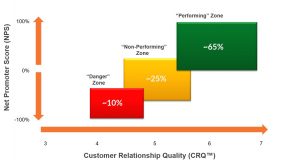Following on from last week’s post on Susan and Bill, we explore what happens next in their story. In particular, we’ll look at the risks of being in the “Danger Zone“.
EPISODE 2: “Performing Zone” or “Danger Zone”?
Susan, Sales Director: “Those Customer Relationship Quality (CRQ) results were incredibly revealing and more than a little scary. Very few of our large accounts are Ambassadors and our biggest account is an Opponent. If we can’t find a way out of the ‘Danger Zone’ Bill and I won’t be working here in 12 months time.”
Bill, Marketing Director: “Deep-Insight have helped us figure out our Net Promoter Score (NPS®). It’s negative. Very negative. At least we know from our Deep-Insight assessment exactly WHAT the problems are, and HOW to tackle them. If we don’t, Susan will be out of a job in 12 months time.”
The last time we met Bill and Susan, they were having relationship problems. Today, they have patched up their differences but they now face a more serious problem. You see, Susan and Bill’s company is in the “Danger Zone” and they need to find a route into a safer, more comfortable place. And they need to find that route quickly.
Last month, Susan and Bill conducted a Customer Relationship Quality (CRQ) assessment of their corporate customers. They invited 300 key contacts in their Top 50 accounts to tell them exactly what they thought of their relationship with the company.
The results were revealing and require immediate action. With a deeply negative Net Promoter Score and a Customer Relationship Quality (CRQ) score that pinpoints a series of issues relating to poor service and low levels of Trust and Commitment, Susan and Bill are not in a good place.
But they know what to do.
The Three Zones
Susan and Bill are like mountaineers on Everest. At more than 8,000m above sea level, the air is thin and oxygen scarce. Mountaineers call this the “Death Zone”. Every mountaineer knows that it’s possible to get the top of Everest, but you can’t stay there for very long or, quite simply, you will die. In fact, anything above 6,000m is dangerous and performance is severely impaired. Mountaineers know that climbing at this level carries a severe risk of permanent damage and at some point – sooner rather than later – they need to descend to safer ground.
Businesses operate in a similar fashion. If your organisation has a positive Net Promoter Score or a CRQ score of 5 or above (CRQ is on a 1-7 scale), it is operating in its “Performing Zone”. Of course, the higher the NPS and CRQ scores, the better. If your NPS is above 30% or your CRQ is above 5.5, the chances are that your customers are extremely loyal and think you are truly unique. Finding new customers is also easy, as your existing customers are a steady source of word-of-mouth referrals.
The opposite is also true. Companies that operate well outside their “Performing Zone” find it difficult to attract new customers and it becomes a constant battle to replace those customers who decide to take their business elsewhere. This is the “Danger Zone”. When a company’s Net Promoter Score falls below -30% and its CRQ score drops below 4.5, it’s in the “Danger Zone” and time to take dramatic action.
Customer Relationship Quality (CRQ)
At least Susan and Bill know they are in trouble, because they have conducted a NPS assessment on their key customers, which has also pointed out exactly WHAT their customer issues are, and HOW they can fix those fractured relationships with their key clients.
Which Zone Are You In?
Of course, your company is unlikely to be in the “Danger Zone.” Our 15 years of working with large multinational B2B companies tells us that only 10% of companies fit into this category.
But we also know that a further 25% of companies are operating in the “Non-Performing Zone”.
Which zone are you in? Would you like to know? Contact us if you want to find out.
Tune in next week for the final episode in the Bill & Susan trilogy!
* Net Promoter® and NPS® are registered trademarks and Net Promoter SystemSM and Net Promoter ScoreSM are trademarks of Bain & Company, Satmetrix Systems and Fred Reichheld



 Susan – Sales Director
Susan – Sales Director Bill – Marketing Director
Bill – Marketing Director
